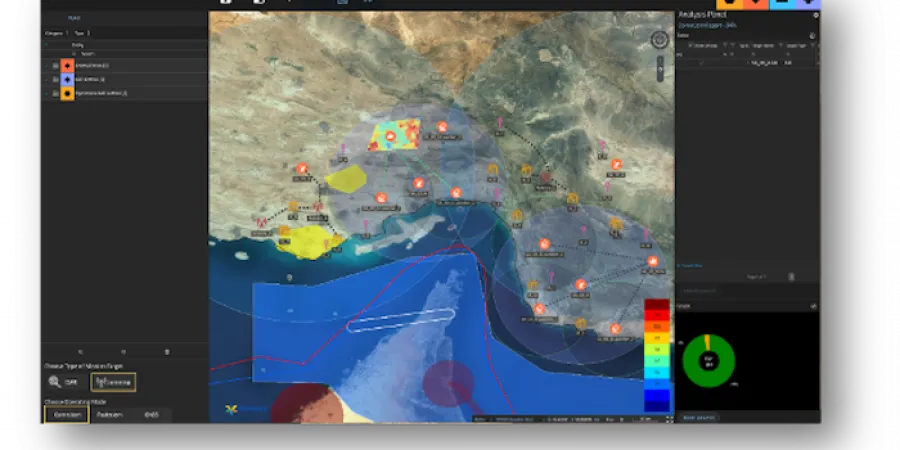AI for ISTAR Mission Planning and Management in the Future Battlefield
Israel Defense
| 27/06/2024
In collaboration with Omnisys
Artificial intelligence (AI) is increasingly becoming a cornerstone of modern military operations. Using AI technologies in intelligence, surveillance, target acquisition, and reconnaissance (ISTAR) missions is expected to revolutionize the way intelligence is utilized on the battlefield.
The ability of AI to process and analyze vast amounts of data at unprecedented speeds and optimize mission-critical parameters is a game changer for the planning and management of intelligence gathering (IG) missions. Traditional methods usually involve manual analysis, which can be time-consuming and susceptible to human error. AI algorithms, on the other hand, can filter huge datasets from various sources, including considering potential sensor performance during changing weather conditions and in different flight configurations of aerial platforms. This allows commanders to make informed decisions quickly, while adapting to dynamic battlefield conditions.
Moreover, AI can simulate various scenarios, predict potential outcomes, and generate recommendations based on probabilistic models. This decision support helps mission planners and commanders to evaluate varying strategies and choose the most effective course of action. The ability to predict enemy moves and respond proactively is a significant advantage in any military operation.
Based on AI technology, Omnisys’ BRO for Intelligence Gathering (BRO-IG) system is designed to support decision-making and improve the planning, management and debriefing of intelligence gathering/ISTAR missions. BRO-IG empowers efficient and optimal allocation of land, air and sea intelligence resources, and optimizes the flight paths of aerial platforms (carrying sensors and optical, electro-optical, SIGINT, radar and SAR systems) according to specific mission objectives.
The BRO-IG system can operate independently or in combination with existing command-and-control (C4I) systems, and is adapted to different operational levels – from the battalion to the headquarters of the chief of staff. BRO-IG enables mission commanders to make better and faster decisions. The system also enables mission operators to overcome the complexity of intelligence technologies, sensors and control units, thereby reducing the amount of operational and human resources required for successful mission execution. This optimization not only improves the effectiveness of intelligence gathering but also ensures that missions are carried out more efficiently and accurately.
BRO-IG is expected to revolutionize ISTAR missions, significantly improving the way intelligence gathering missions are planned and managed. The BRO-IG system has the ability to process vast amounts of data, provide real-time insights, streamline resource allocation, optimize flight routes, and improve decision-making processes. Thanks to BRO-IG, the future of intelligence gathering is expected to be more efficient and accurate.
Successfully integrating AI within the planning and management of ISTAR missions requires experience and skill. As technologies continue to evolve, the future of battlefield management will depend on the capabilities of AI. We must continue analyzing and understanding how AI’s advantages contribute to streamlining the mission planning and management processes, as well as providing insights that will enable superiority on the battlefield.
For additional information about BRO-IG and other Omnisys BRO systems, visit the Omnisys site.
Artificial intelligence (AI) is increasingly becoming a cornerstone of modern military operations. Using AI technologies in intelligence, surveillance, target acquisition, and reconnaissance (ISTAR) missions is expected to revolutionize the way intelligence is utilized on the battlefield.
The ability of AI to process and analyze vast amounts of data at unprecedented speeds and optimize mission-critical parameters is a game changer for the planning and management of intelligence gathering (IG) missions. Traditional methods usually involve manual analysis, which can be time-consuming and susceptible to human error. AI algorithms, on the other hand, can filter huge datasets from various sources, including considering potential sensor performance during changing weather conditions and in different flight configurations of aerial platforms. This allows commanders to make informed decisions quickly, while adapting to dynamic battlefield conditions.
Moreover, AI can simulate various scenarios, predict potential outcomes, and generate recommendations based on probabilistic models. This decision support helps mission planners and commanders to evaluate varying strategies and choose the most effective course of action. The ability to predict enemy moves and respond proactively is a significant advantage in any military operation.
Based on AI technology, Omnisys’ BRO for Intelligence Gathering (BRO-IG) system is designed to support decision-making and improve the planning, management and debriefing of intelligence gathering/ISTAR missions. BRO-IG empowers efficient and optimal allocation of land, air and sea intelligence resources, and optimizes the flight paths of aerial platforms (carrying sensors and optical, electro-optical, SIGINT, radar and SAR systems) according to specific mission objectives.
The BRO-IG system can operate independently or in combination with existing command-and-control (C4I) systems, and is adapted to different operational levels – from the battalion to the headquarters of the chief of staff. BRO-IG enables mission commanders to make better and faster decisions. The system also enables mission operators to overcome the complexity of intelligence technologies, sensors and control units, thereby reducing the amount of operational and human resources required for successful mission execution. This optimization not only improves the effectiveness of intelligence gathering but also ensures that missions are carried out more efficiently and accurately.
BRO-IG is expected to revolutionize ISTAR missions, significantly improving the way intelligence gathering missions are planned and managed. The BRO-IG system has the ability to process vast amounts of data, provide real-time insights, streamline resource allocation, optimize flight routes, and improve decision-making processes. Thanks to BRO-IG, the future of intelligence gathering is expected to be more efficient and accurate.
Successfully integrating AI within the planning and management of ISTAR missions requires experience and skill. As technologies continue to evolve, the future of battlefield management will depend on the capabilities of AI. We must continue analyzing and understanding how AI’s advantages contribute to streamlining the mission planning and management processes, as well as providing insights that will enable superiority on the battlefield.
For additional information about BRO-IG and other Omnisys BRO systems, visit the Omnisys site.



